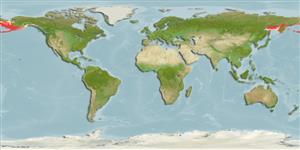Environment: milieu / climate zone / depth range / distribution range
Ecology
Marine; demersal; depth range 0 - 325 m (Ref. 50610). Temperate; 65°N - 51°N, 140°E - 138°W (Ref. 57309)
North Pacific: Kotzebue Sound to the northern Sea of Japan, Sea of Okhotsk and Akun Island in the Aleutian chain (Ref. 6793); and adjacent Arctic, including Gulf of Alaska (Ref. 51659).
Size / Weight / Age
Maturity: Lm ? range ? - ? cm
Max length : 21.6 cm SL male/unsexed; (Ref. )
Dorsal spines (total): 8 - 11; Dorsal soft rays (total): 6 - 9; Anal spines: 0; Anal soft rays: 13 - 16. Suprapectoral plates absent. Pectoral fin with 5 rows of blackish-brown spots. Resembles O. iburia in having blackish-brown spots on the pectoral fin, but differs by having no sub pectoral plate, 42 or fewer lateral line plates, and 30 to 37 supralateral plates.
Life cycle and mating behavior
Maturities | Reproduction | Spawnings | Egg(s) | Fecundities | Larvae
Robins, C.R., R.M. Bailey, C.E. Bond, J.R. Brooker, E.A. Lachner, R.N. Lea and W.B. Scott, 1991. Common and scientific names of fishes from the United States and Canada. Am. Fish. Soc. Spec. Publ. (20):183 p. (Ref. 3814)
IUCN Red List Status (Ref. 130435)
Threat to humans
Harmless
Human uses
Tools
Special reports
Download XML
Internet sources
Estimates based on models
Preferred temperature (Ref.
123201): -1.1 - 5.4, mean 1.9 °C (based on 531 cells).
Phylogenetic diversity index (Ref.
82804): PD
50 = 0.5625 [Uniqueness, from 0.5 = low to 2.0 = high].
Bayesian length-weight: a=0.00389 (0.00180 - 0.00842), b=3.12 (2.94 - 3.30), in cm total length, based on all LWR estimates for this body shape (Ref.
93245).
Trophic level (Ref.
69278): 3.2 ±0.4 se; based on diet studies.
Resilience (Ref.
120179): Medium, minimum population doubling time 1.4 - 4.4 years (Preliminary K or Fecundity.).
Fishing Vulnerability (Ref.
59153): Low vulnerability (16 of 100).
